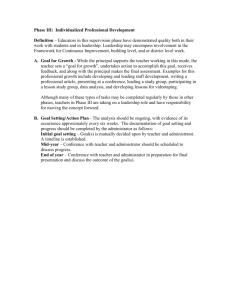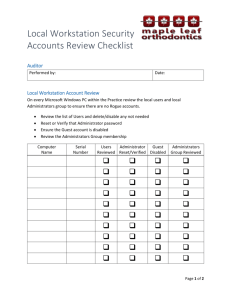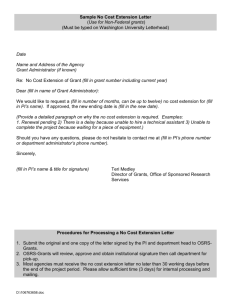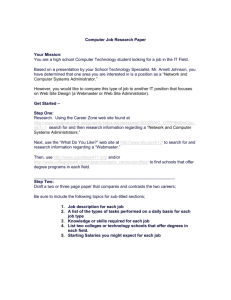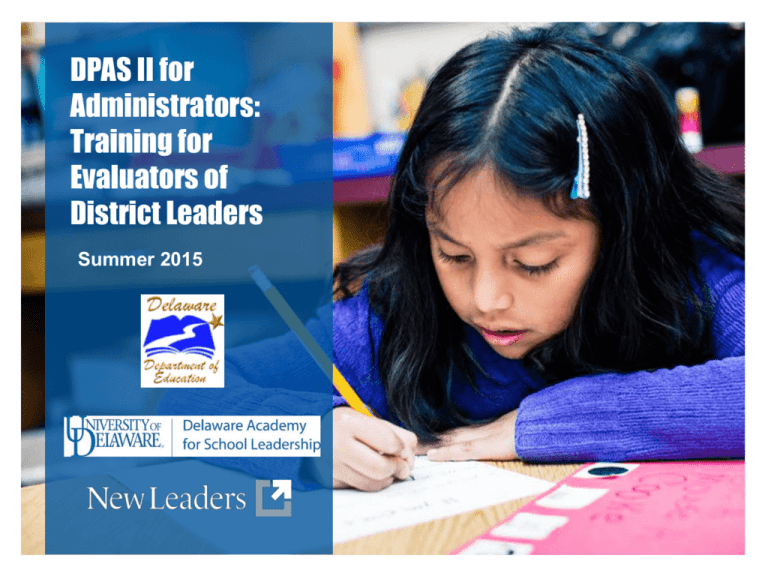
DPAS II for
Administrators:
Training for
Evaluators of
District Leaders
Summer 2015
Session Outcomes
As a result of active participation, superintendents and
other supervisors of district administrators will:
1.
Be prepared to implement the DPAS II for administrators appraisal cycle
for district administrators in SY15-16
2.
Increase their understanding of Delaware’s definition of effective district
administrator leadership and how that is reflected in the appraisal rubric
3.
Increase their skills in key areas of evaluation, including:
4.
•
assessing the quality of student performance targets for district administrators
•
helping administrators establish leadership practice priorities
•
providing accurate and actionable feedback to individual leaders
Have key action steps for implementing the evaluation system for
district administrators
© New Leaders, Inc. All rights reserved. | 2
Today’s Agenda
1. Welcome and overview of the day
2. Review of Purpose of District Administrator Evaluation
3. Overview of the Guide for Evaluating District Administrators
4. Goal Setting
5. Assessing Leadership Practice
6. Implementation: Superintendents Sharing Practices
7. Close the day
© New Leaders, Inc. All rights reserved. | 3
Review of Purpose of District
Administrator Evaluation
Warm-up
Think about your own experience as a district administrator (other
than in the superintendent role). Think about how you were evaluated.
Write down your reflections on these questions:
•
What was the process?
•
How did your supervisor know how you were doing in your job?
•
What aspects of being an administrator were the focus of your evaluation?
•
In what ways was your evaluation helpful? In what ways was it unhelpful?
Turn to a neighbor and share your reflections.
© New
Leaders,
rights
reserved.
© New
Leaders,
Inc.Inc.
All All
rights
reserved.
| 5|
How Districts Organize for Success
Help leaders
grow and
succeed
Service to
schools
Align actions
to vision
© New Leaders, Inc. All rights reserved. | 6
Key Ideas in DPAS II for Administrators
Provides
space for
professional
judgment
Supports
professional
growth
Communicates
key messages
about district
leadership
Facilitates
quality talent
management
© New Leaders, Inc. All rights reserved. | 7
Reflections
•
What is your for vision for your school district?
•
What are the key contributions of district leaders to the accomplishing the vision and pursuing the
strategy?
•
How can you leverage the evaluation system to keep a focus on the vision and strategy?
•
How do you provide support to administrators to facilitate this?
Share reflections with a partner.
© New
Leaders,
rights
reserved.
© New
Leaders,
Inc.Inc.
All All
rights
reserved.
| 8|
Who Counts as a “District Administrator?”
DPAS-II Evaluation is
required for…
Licensed and certified
administrators who oversee
instruction
DPAS-II Evaluation is not
required for…
Administrators who supervise noninstructional aspects of school and
district operations such as but not
limited to, transportation,
maintenance, finance, nutrition,
discipline and personnel.
Who is in the grey area?
Take 3 minutes to sketch out who you think is in and who is out.
Discuss at tables and be prepared to share questions and decisions.
© New Leaders, Inc. All rights reserved. | 9
Effective Leadership Brainstorm
Take 3 minutes on your own to list what it takes – skills, knowledge,
habits, mindsets – to be an effective district administrator in your
school district
Share and compare with your table group. Where are there
similarities? Differences?
© New
Leaders,
Inc.rights
All rights
reserved.
© New
Leaders,
Inc. All
reserved.
| 10|
Toward a Shared Vision of Administrator Effectiveness
Practice based on
each district’s
definition of
effectiveness
Practice supported
by a common
definition
Practice supported
by a common
definition and
shared practice
© New Leaders, Inc. All rights reserved. | 11
Overview of Guide for Evaluating
District Administrators
The Guide
Review each section. What are the “MUST KNOWS” in each section.
© New Leaders, Inc. All rights reserved. | 13
Timing and Steps
Recommendation: Start and end with
district administrator evaluations.
© New Leaders, Inc. All rights reserved. | 14
Five Components of District Administrator Evaluation
1. VISION AND GOALS
2. TEACHING AND LEARNING
3. PEOPLE, SYSTEMS, AND
OPERATIONS
4. PROFESSIONAL
RESPONSIBILITIES
5. STUDENT IMPROVEMENT
© New Leaders, Inc. All rights reserved. | 15
Leadership Practice Components and Criteria
1. VISION AND GOALS
2. TEACHING AND LEARNING
•
•
•
•
•
Communicates the district's vision for high
student achievement and college and career
readiness
Develops, monitors, and adjusts strategies to
meet goals of the district strategic plan
Builds a culture focused on service to schools
and student outcomes
Advocates for cultural competence and a
commitment to equity
•
•
•
Supports the development of rigorous curricula
and assessments aligned to state standards
Supports quality instructional practices
Provides integrated data systems to allow
schools and departments to accurately analyze
student data and drive instructional practice
Utilizes professional learning to develop the
capacity of all educators and school
instructional leaders
3. PEOPLE, SYSTEMS, AND
OPERATIONS
4. PROFESSIONAL
RESPONSIBILITIES
•
•
•
•
•
Increases school leader and/or district staff
effectiveness through evaluation and support
Enables schools and district to attract, hire, and
retain top-quality candidates at all levels,
including teachers, school leaders, and central
office staff
Obtains, allocates and aligns resources in
alignment with district plan
Establishes, monitors, and analyzes policies &
systems from the district to the school level
•
•
•
Builds professional relationships and
constructively manages change
Engages in self-reflection and on-going
professional development
Demonstrates a persistent focus on proactive
problem solving
Exhibits professionalism in service to all
community stakeholder groups
© New Leaders, Inc. All rights reserved. | 16
Assessing Leadership Practice (Components 1-4)
Highly Effective
Expert level of performance across components + build the capacity of others to lead
Effective
Effective leadership practices across components
Needs Improvement
Knowledge and awareness of effective leadership practices, but not consistent execution
Ineffective
Unacceptable levels of performance on one or more components
© New Leaders, Inc. All rights reserved. | 17
Assessing Student Improvement (Component V)
Part
Description
Possible Measures
A
Improvement in
Student Scores on
State Administered
Assessments in ELA
and Mathematics
Improvement in rate
of students meeting
goals on ELA and
Mathematics
assessments
Improvement in rate
of students meeting
goals on other local
priorities
None for SY 15-16
B, Section 1
B, Section 2
Possible
Points
0 for SY 1516
Method for Calculating
Points
N/A
0-50
Locally-Determined
State-approved measures, other
0-50
state-recommended measures,
current success plan measures
pertaining to student performance,
or other district priority student
achievement measures
Locally-Determined
State approved assessments of
ELA and Math
© New Leaders, Inc. All rights reserved. | 18
Key Steps: Goal-Setting
Student Improvement
(Required)
• Two goals (ELA/Math + Other)
• Measure, baseline data, and target
Leadership Priority Areas
(Recommended)
• Leadership actions connected to criteria
• Indicators of success
© New Leaders, Inc. All rights reserved. | 19
Five Components of District Administrator Evaluation
1. VISION AND GOALS
2. TEACHING AND LEARNING
3. PEOPLE, SYSTEMS, AND
OPERATIONS
4. PROFESSIONAL
RESPONSIBILITIES
5. STUDENT IMPROVEMENT
© New Leaders, Inc. All rights reserved. | 20
Key Steps: Evidence Collection
Direct
Observation
Indirect
Observation
Artifacts
Department
Data
The
evaluator is
physically
present
where the
administrator
is present
and leading
The
evaluator is
observing
systems that
but operate
without the
leader
present
Materials
that
document
administrator
practice
Concrete
results of a
leader’s
work
© New Leaders, Inc. All rights reserved. | 21
Key Steps: Evidence Collection
© New Leaders, Inc. All rights reserved. | 22
Key Steps: Evidence Collection
Principal
Supervision
Student
support and/or
targeted
student
populations
Curriculum,
instructional
materials, and
assessment
© New Leaders, Inc. All rights reserved. | 23
Key Steps: Mid-Year Conference
Critical Questions:
• What actions has the administrator taken to accomplish goals?
• What positive accomplishments would the administrator share?
• What evidence exists of progress toward goals?
• What resources/supports does the principal need to help accomplish their goals?
© New Leaders, Inc. All rights reserved. | 24
Key Steps: Summative Evaluation
Leadership Practice
(Components 1-4)
Student Improvement
(Component 5)
Effective (E) or Highly Effective (HE) on all
four
Exceeds
E or HE on at least three +
No Ineffective (I)
Satisfactory (or higher)
Needs Improvement
E or HE on one or two + Fewer than three I
Satisfactory (or higher)
Needs Improvement
E or HE on three or more
Unsatisfactory
Needs Improvement
E or HE on three + one I
Satisfactory (or higher)
Ineffective
E or HE on zero, one or two
Unsatisfactory
Ineffective
E or HE on zero
Satisfactory (or higher)
Ineffective
Three or more I
Any rating
Highly Effective
Effective
© New Leaders, Inc. All rights reserved. | 25
Processing
Take a few minutes to read back through the guide. Then we will take
questions to ensure your understanding.
QUESTIONS?
© New
Leaders,
Inc.rights
All rights
reserved.
© New
Leaders,
Inc. All
reserved.
| 26|
Goal-Setting: Assessing the
Quality of Student Improvement
Goals
Alignment of Improvement Goals
State of Delaware
accountability system and goals
District
performance targets and multi-year goals
School
performance targets and multi-year goals
Administrator
Student improvement goals
Teacher
Student performance measures
© New Leaders, Inc. All rights reserved. | 28
Guiding Principles for Goal-Setting
DOE Policy statement
Select the right measures
Set the right targets
Determine how progress to goals will
be assessed mid-year and EOY
Identify leadership priority areas
connected to goals (Recommended)
© New Leaders, Inc. All rights reserved. | 29
Sharing Best Practices: Goal Setting
Some of your colleagues are here to share their perspectives on
setting goals.
•
Walk through your process for setting district goals and describe how evaluation connects to that
work?
•
What prep work do you and your administrators do in advance?
•
How do you make the links between student improvement goals and leadership performance
areas?
•
Walk through your own process for assessing the quality of student improvement goals.
Additional questions?
© New
Leaders,
Inc.rights
All rights
reserved.
© New
Leaders,
Inc. All
reserved.
| 30|
The Student Improvement Goal “Quality” Test
•
Data
Analysis
•
•
•
•
Explain how the goal demonstrates alignment to district priorities.
Does the goal provide an opportunity for the targeted schools or student
groups to move in a coordinated effort toward increases in student
achievement? Provide a rationale.
•
Explain how the assessments help you track progress on the goals and
what important benchmarks exist throughout the year.
Explain how the measures allow you to track growth in addition to
attainment, particularly if the goal calls for it.
Alignment
•
Measures
•
•
Strategies
How does the goal address a critical area of growth for the students
influenced by the work of the district administrator?
Does one goal align to a state-approved measure B assessment, and is the
other goal clearly focused on improving a key student outcome?
Is the target informed and driven by past performance? Describe.
Describe how the administrator identified strategies (Components I-IV) will
support the target that has been set.
Have the targeted schools set goals that are aligned to the district
administrator’s goals, or does the district administrator goal roll up from
school-level goals?.
© New Leaders, Inc. All rights reserved. | 31
District Student Improvement Goal: An example
Time bound to June, but set up to
track progress on NWEA/MAP
benchmark administrations throughout
year.
Reading level set up to monitor and measure student
growth. This goal also addresses grades not tested in
state assessment data.
By June 2016, 85% of 2nd and 3rd grade students
district-wide will reach or exceed their RIT projected
growth score in English Language Arts as measured by
the NWEA/MAP assessment.
Assessment measure has three
administrations which allows for
monitoring benchmark growth toward
goal. Grade level goals are clearly
outlined.
Setting ambitious goals for students early on
is instrumental in moving toward district goal
of every child reading at grade level in 3rd
grade
© New Leaders, Inc. All rights reserved. | 32
Work Session: Write Student Improvement Goals
Set goals and targets for an administrator you supervise.
Step 1: Consider your District’s goals for district-wide
improvement.
Step 2: Write one or two student improvement goals for the
administrator within the context of a District goal.
Step 3: Reflect on how well the goals you set meet the
requirements of the quality test.
© New Leaders, Inc. All rights reserved. | 33
Give Feedback | Get Feedback
Take your Goal Setting Forms and…
1.
Find a partner from a different table who you do not know or
have not worked with today
2.
Each partner will get 5 minutes to explain their completed
forms (rationale, connection to District goals, etc).
3.
After the measures/targets are shared the partner will ask
clarifying questions, apply the “quality test”, and identify
strengths
4.
Return to your seat to refine your measure after the “quality
test”
© New Leaders, Inc. All rights reserved. | 34
Checking for Understanding
What strikes you as critical when carrying out this process in your
own district? What needs to be in place to get a robust goal-setting
process ready to go for 2015-2016?
What questions, concerns, ideas do you have about goal setting?
© New
Leaders,
Inc.rights
All rights
reserved.
© New
Leaders,
Inc. All
reserved.
| 35|
LUNCH
© New Leaders, Inc. All rights reserved. | 36
Assessing Leadership Practice
Standards and Rubric Connection
DPAS II Component
Delaware Administrator Standards
(Six ISLLC)
1. Vision and Goals
A vision of Learning
2. Teaching and Learning
School Culture and Instructional
Program
3. People, Systems and Operations
The Management of Learning
4. Professional Responsibilities
Family and Community Collaboration
Ethics
Societal Context
© New Leaders, Inc. All rights reserved. | 38
Rubric Design
• Directly linked to ISLLC standards.
• Each component has four criteria and are the basis upon which the
performance of an administrator is evaluated.
• Each criterion has four performance levels described in the rubric.
© New Leaders, Inc. All rights reserved. | 39
Content and Language of the Rubric
•
Provides lens for evaluating administrators
•
Articulates new performance descriptors for
highly effective and effective leadership
•
Provides common language to describe
leadership practice
•
Puts focus on evidence to describe level of
performance
•
Orients feedback toward professional
growth with descriptors
© New Leaders, Inc. All rights reserved. | 40
Understanding the Effective Column of the Rubric
© New Leaders, Inc. All rights reserved. | 41
Find the Big Ideas in Component 1
Read carefully down the effective column and take notes on two
things.
1.
What are the big ideas in Component 1?
2.
What are the big cross-cutting themes?
Glance at the Highly Effective column. What changes to get an administrator to this rating?
Chart the “Big Ideas” at your table.
© New
Leaders,
Inc.rights
All rights
reserved.
© New
Leaders,
Inc. All
reserved.
| 42|
Examples of Evidence
What would be some key pieces of evidence that
you may observe, gather, or discuss for
Component 1?
Reference page 38
On the “Big idea” chart, write these examples.
Share with another group.
© New Leaders, Inc. All rights reserved. | 43
Find the Big Ideas in Component 2 & 3
Read carefully down the effective column and take notes on two
things.
1.
What are the big ideas in Components 2 & 3?
2.
What are the big cross-cutting themes?
Glance at the Highly Effective column. What changes to get an administrator to this rating?
Chart the “Big Ideas”
© New
Leaders,
Inc.rights
All rights
reserved.
© New
Leaders,
Inc. All
reserved.
| 44|
Examples of Evidence
What would be some key pieces of evidence that
you may observe, gather, or discuss for
Components 2 and 3?
Reference page 38
On the “Big idea” chart, write these examples.
Share with another group.
© New Leaders, Inc. All rights reserved. | 45
Find the Big Ideas in Component 4
Read carefully down the effective column and take notes on two
things.
1.
What are the big ideas in Component 4?
2.
What are the big cross-cutting themes?
Glance at the Highly Effective column. What changes to get an administrator to this rating?
Chart the “Big Ideas”.
© New
Leaders,
Inc.rights
All rights
reserved.
© New
Leaders,
Inc. All
reserved.
| 46|
Examples of Evidence
What would be some key pieces of evidence that
you may observe, gather, or discuss for
Component 4?
On the “Big idea” chart, write these examples.
Share with another group.
© New Leaders, Inc. All rights reserved. | 47
Checking for Understanding
What strikes you as important about the rubric and the ideas
embedded in it?
What strikes you as challenging?
What other questions, concerns, ideas do you have about the
rubric?
© New
Leaders,
Inc.rights
All rights
reserved.
© New
Leaders,
Inc. All
reserved.
| 48|
REVISITING Who Counts as a “District Administrator?”
DPAS-II Evaluation is required
for…
Licensed and certified
administrators who oversee
instruction
DPAS-II Evaluation is not
required for…
who supervise non-instructional
aspects of school and district
operations such as but not limited
to, transportation, maintenance,
finance, nutrition, discipline and
personnel.
Who is in the grey area?
Get out your list of who is in and who is out. Determine based on
your rubric study if you would move anyone in or out. Note the
criteria you would use in Component 2 and Component 3 for each.
© New Leaders, Inc. All rights reserved. | 49
Five Components of District Administrator Evaluation
1. VISION AND GOALS
2. TEACHING AND LEARNING
3. PEOPLE, SYSTEMS, AND
OPERATIONS
4. PROFESSIONAL
RESPONSIBILITIES
5. STUDENT IMPROVEMENT
© New Leaders, Inc. All rights reserved. | 50
Implementation:
Strategies of Superintendents
Sharing Best Practices
Some of your colleagues are here to share their perspectives on
implementing district administrator evaluation.
•
Walk through your process for collecting evidence throughout the year.
•
With frequent interaction that comes with the close work of district administrators, how do you
capture evidence?
•
How and when do you hold conversations to check on progress? At mid-year or more frequently?
•
What are the most complex cases you have when it comes to evaluating your district
Additional questions?
© New
Leaders,
Inc.rights
All rights
reserved.
© New
Leaders,
Inc. All
reserved.
| 52|
Getting Ready for Implementation
Take 15 minutes to sketch out key action steps for yourself?
•
What do I need to communicate now to administrators I supervise?
•
What actions do I need to take before the school year starts?
•
What questions do I still have?
Find a new partner and share your action steps.
•
Facilitators will float to give feedback and address questions.
© New
Leaders,
Inc.rights
All rights
reserved.
© New
Leaders,
Inc. All
reserved.
| 53|
Close the Day
Wrap up
Complete evaluation form, please
e
Thank you so much for your contributions today!
Shannon Holston
Shannon.Holston@doe.k12.de.us
Dr. Tammy Croce
Dr. John Kreitzer
tjcroce@udel.edu
johnk@udel.edu
© New Leaders, Inc. All rights reserved. | 55

